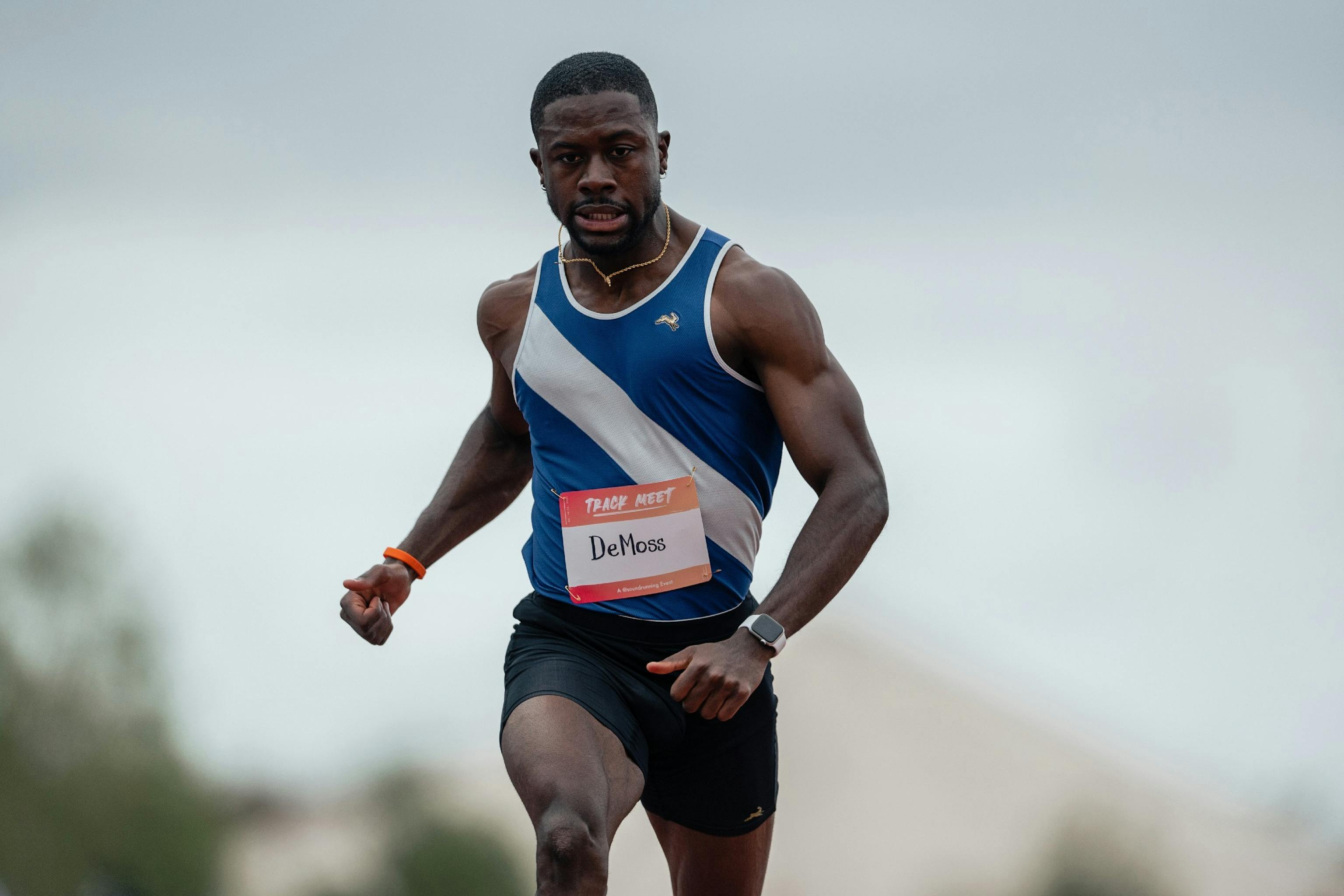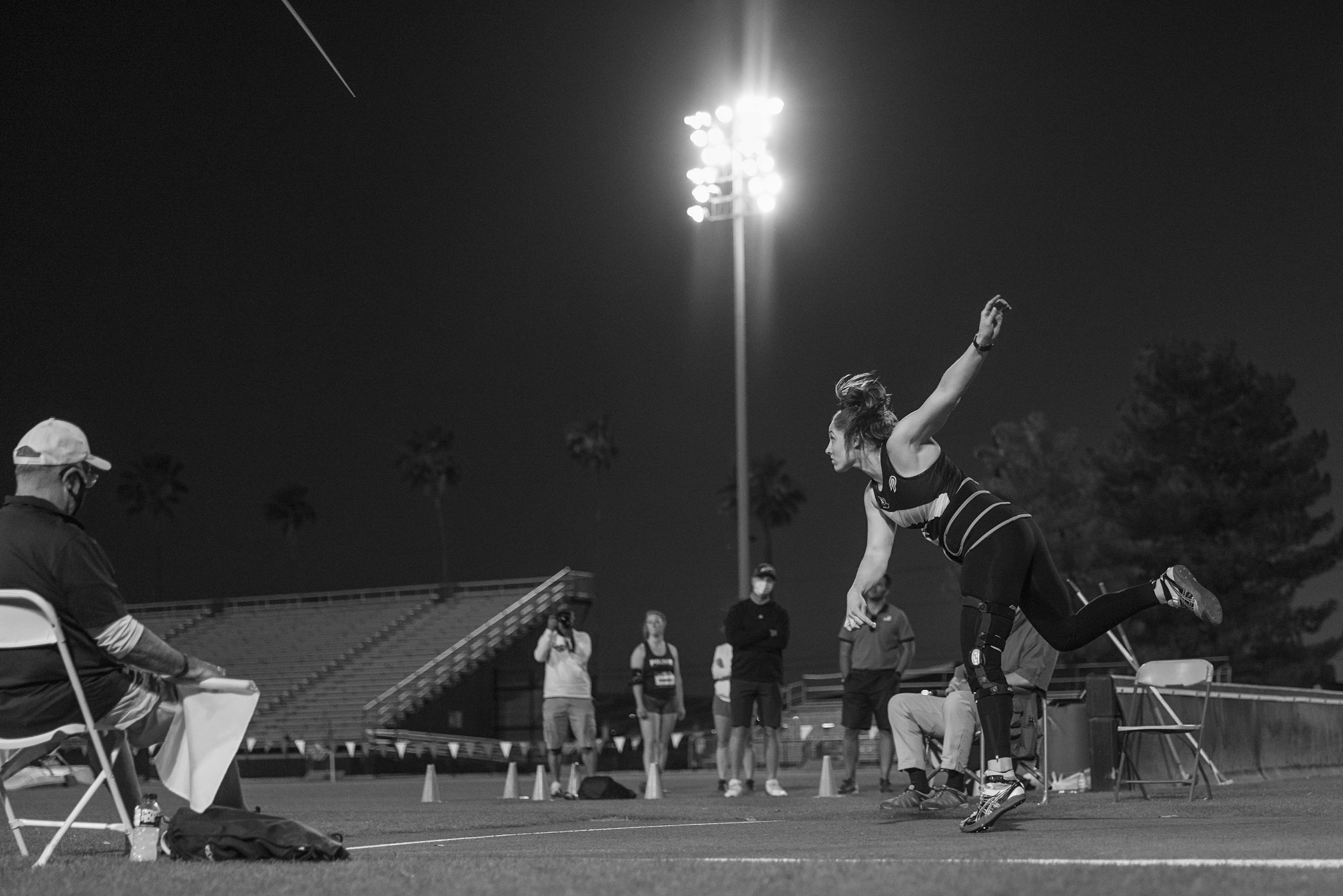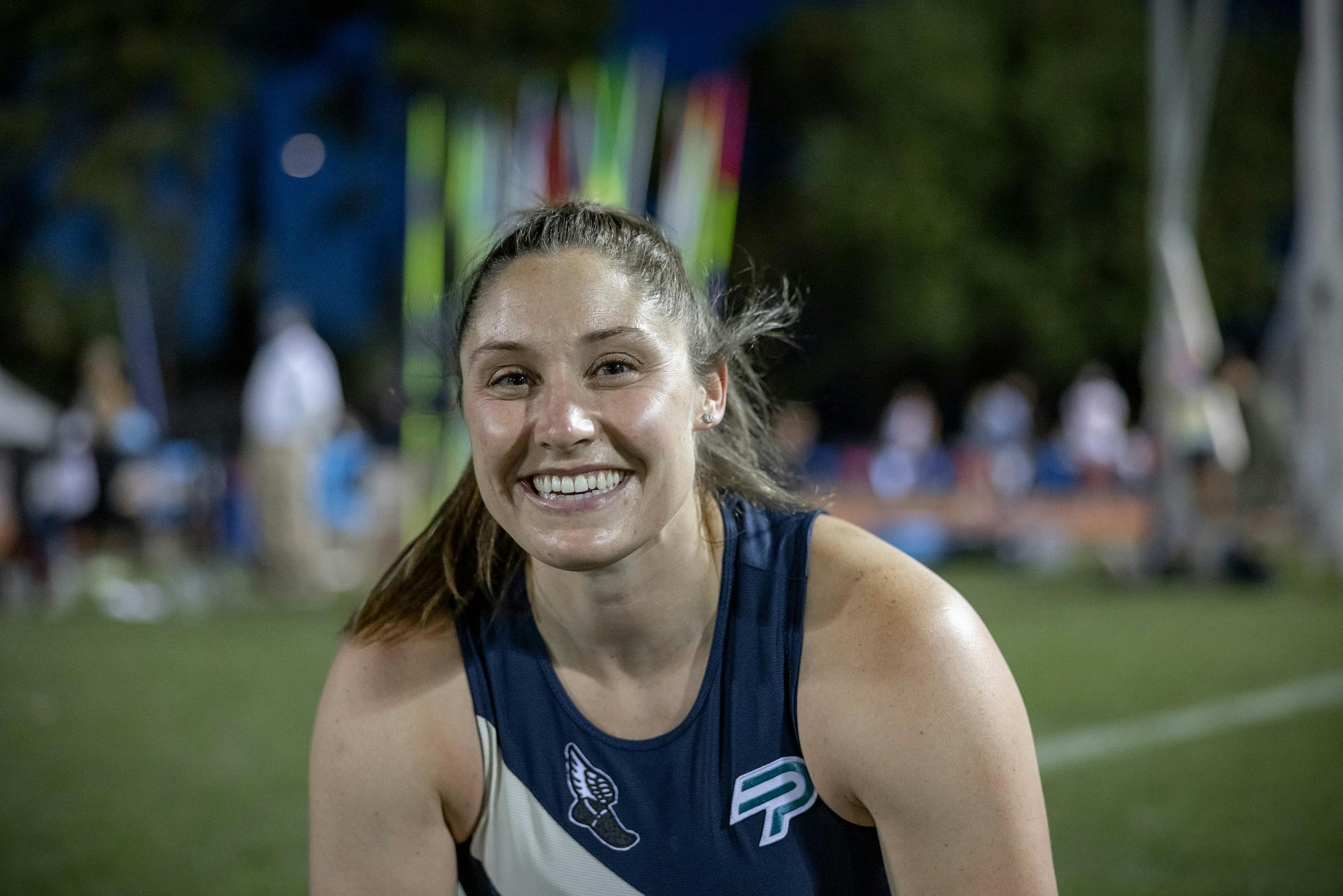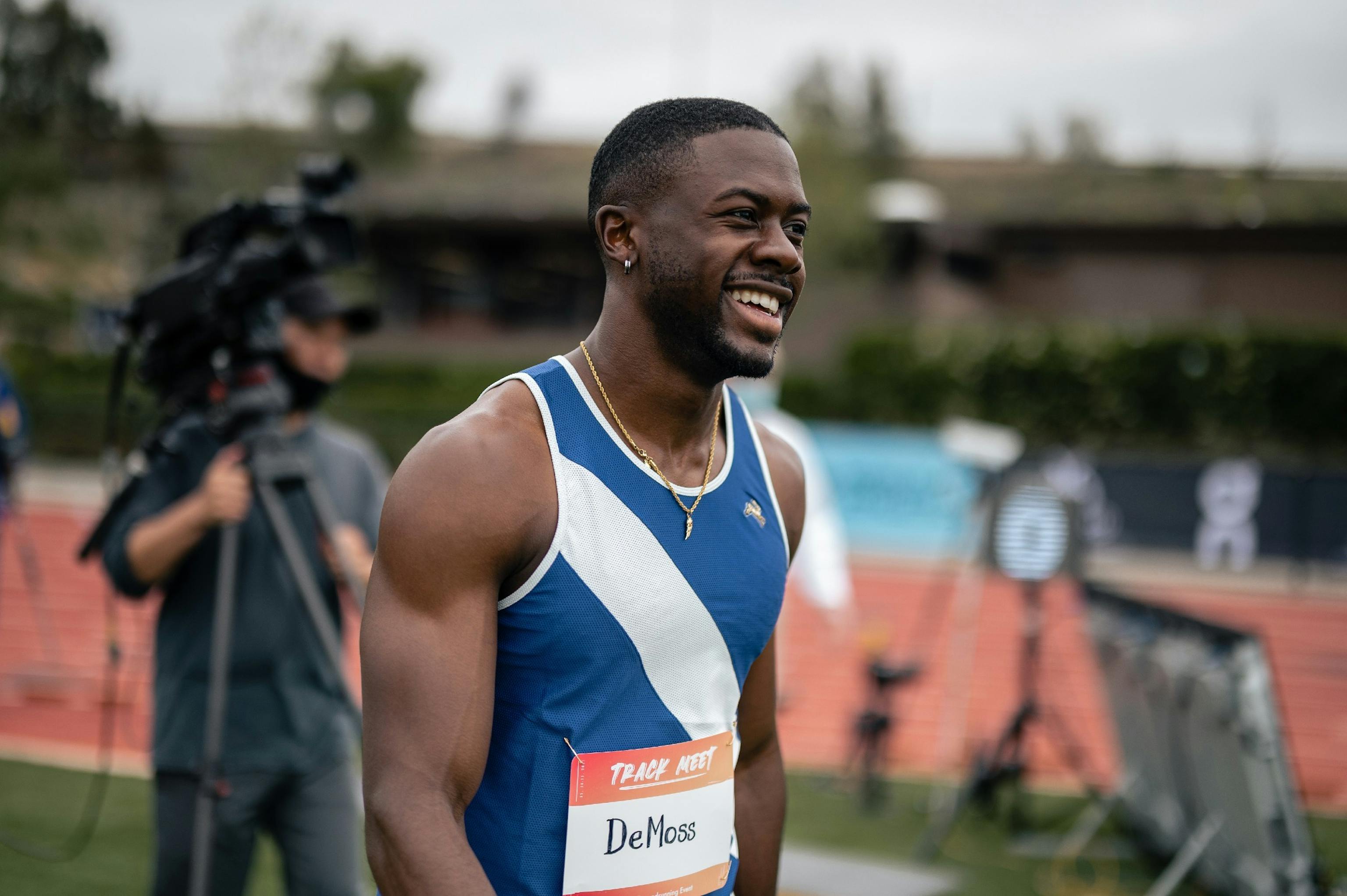
Dueling Disciplines
Kara Winger
vs
Davon DeMoss
Interview by Harry Gould
In this week’s Dueling Disciplines, we pitch javelin-throwing Olympian Kara Winger against Trials-hopeful, sprinter Davon DeMoss.
Kara Winger has been through this rodeo before. She is a three-time Olympian in the javelin, her first while she was still competing at Purdue University. After a long recovery from an ACL tear at the end of last summer, Kara opened her season with a strong 60.97m. With lots of momentum building, she is going to be a force to be reckoned with at the Trials.
Davon DeMoss is a sprinter based in Memphis, Tennessee. After only starting his senior year of high school, he was able to walk-on to the team at the University of Memphis. There, he made big jumps in time as he grew closer til the sport. In his final collegiate race at the NCAA National Championships, he ran a 10.05 to qualify for the Olympic Trials. After waiting a whole year, Davon finally gets a chance to chase his dreams.
Kara: I competed this past weekend and yesterday (May 25th) marked nine months after my second ACL surgery so it was a huge weekend in terms of confidence. It went really well. I might not even need to compete again until Trials. It would be good for me to just rest and dial in my training and prepare for Eugene. How about you?
Davon: Coming up, I’ve got a meet in Orlando, the Pure Summer Invitational. I’m looking forward to running the 100m and the 200m. It’s also the first time I’m going to be running in good weather. Hopefully the wind is with me and I can put some good times down.
K: I’ve always been interested in whether runners need a few meets to feel sharp or are you good from the get-go?
D: I would say I am a rhythmic runner. Usually by the time late May rolls around, I’ve run 30 or so races. At the moment I’m at 12. Currently, I wouldn’t say I’m running bad, I’m just not where I would like to be. But it's getting better so I’m optimistic about it.
K: 30 races is mind blowing to me. But I guess between winter and spring that makes sense. I threw weight in college for one indoor season and then ended up redshirting medically that outdoor season so I am definitely not an endurance competitor. In total contrast, I turned 35 in April; this is my 20th season as javelin thrower. A long year for me is 12 total competitions.
D: Well, when you add up doing multiple races each meet and relays it’s not as many as it sounds like.
K: I’ve always been so dialed in on javelin that it’s crazy to me how much you do. To this day, people still ask me, “what else do you do?” and all I can respond with is “just the javelin, that’s it!” This isn’t the first Olympic year that I’ve had very few competitions leading up to it. In 2016, I had a shoulder surgery the fall prior and just wasn’t ready until around early June. So, this isn’t exactly uncharted territory for me.


D: I know that you’ve been to three Olympics now. That must take so much mental strength to prepare for. What’s your process to get ready for big meets?
K: Early on, it can feel like the whole world is ahead of you. Taking every opportunity for what it is and soaking all of the experiences in has really helped me realize when it’s time to show up. My strength coach and my technical coach are two of my best friends, it’s so much fun to travel the world and try to be the best we can be together. I trust these people so much and I’ve known them for 10 plus years. They’re my backboard. Do you prioritize training with a group and your relationship with your coach or is it more of just making it work?
D: I’ve had four different coaches and I’ve been sprinting for six years. I’ve definitely built a relationship with all of them but in each situation they’ve either resigned or moved on to a different school. I have a pretty good relationship with my fourth coach, Sharese Hicks. Of all my coaches, she’s put forth the most effort. All of my coaches have definitely cared and definitely tried, but she’s taken that extra step.
K: Even if it’s hard to define, you can just tell what that edge is and it gives you a mental edge too!
D: I can tell how much it means to her. As far as a training group, I’m still training with my former collegiate team. I’ve thought about going to a pro group in places like California, Texas, or Florida next year if I continue to run. With everything going on, it is best for me to just stay in Memphis and train here.
K: When I made my first Olympic team in 2008, I was a junior at Purdue and I still had another year of eligibility. That home base atmosphere when I returned was super great for me. What was COVID as a senior in college like? That must have been miserable!
D: I actually graduated from the University of Memphis in 2019 but COVID happened during my first professional season. Just like everyone else, it caught me off guard. I was building super well beforehand. Coming off a strong senior year, I was even more excited for the 2020 Olympic Trials. But then everything just stopped. I ended up back home with my parents and had a lot of different changes.
K: I own a home in Colorado Springs. I was way more successful as a javelin thrower than I ever expected to be, even right out of college. So, I saved all this money and as a javelin thrower I was like I better not spend any of it because who knows when it’ll all go away. So, COVID for me was very different from a lot of people. I kept thinking about fresh college graduates. I can’t believe the Olympic privilege that I have. I thought about people like you all year who have just graduated and now have this huge thing that no one knows how to deal with.
D: There was definitely a while where I thought about putting sport behind me and just going with what my degree is. But, I wanted to give it one last shot.
K: In contrast, I just got to stay home and my husband built a weight room on our deck and I got to lift outside all summer in Colorado. There are paths near my house to sprint on so I just kept training. I actually threw very far at the end of the summer. The people in dorm rooms or housing who weren’t interested in staying long term must’ve had a tough time. I don’t think I would have been as mentally strong as those people. It’s amazing to see great results come out of it.

How did you decide to pursue track after college?
K: I made an Olympic team in college and I thought to myself, “I could probably keep doing this.”
D: Haha! That makes it an easy choice.
K: It was still a bit of a wild ride though. I had a few tough seasons and it wasn’t until 2009 when I threw a big PR at USAs. I really struggled going right to Europe to compete after college. I was questioning my decision. I was alone on the other side of the world not performing well. There were two final meets in Japan and South Korea at the end of September after starting my season in March. I just wanted to go and see what I was capable of and prove I’m not done yet. I ended up winning my first international competition in Kawasaki and threw over 60m. At first, I kept asking myself what I was doing but that really helped solidify my choice and showed to myself that I belonged there.
D: I made my decision after NCAAs 2019. I was able to run 10.05 which was the Olympic A Standard. With the Trials next year, I figured it would be silly not to continue training for that. I was also the first man out in the NCAA finals for the 100m. That kept a fire under me. The second thing that helped make the decision was that I only started running track my senior year of high school. I had a young training age and have gotten better every year. I have a lot more to give. It helped that my parents were both behind it.
K: I don’t know if you’ve experienced this yet because you’re so young, but have you had a hint of how cool it is to travel the world and be an athlete?
D: I have, I have. I haven’t gotten the opportunity to travel overseas yet. But it’s just so much fun to travel around and compete. It’s different doing it without the team but you see the same people at each meet and start to build connections with each other. I definitely like the lifestyle.
K: The community and the relationships that you form because you do this very weird thing is one of my favorite things about it. I guess it’s not as weird to be a sprinter as a javelin thrower.
Starting track senior year of high school
D: Basically, I played basketball all four years of high school and I thought I was going to play in college, but unfortunately my skills had a different plan. My friend told me to come out and run track. My basketball season was over, and I wasn’t going to play baseball, so I figured I’d give it a try. I ended up being pretty good from day one. I didn’t make States or anything but had a decent season. I ended up walking on at Memphis and that's where I fell in love with it.
K: What a wild ride! Such a fast turnaround.
D: Yeah, I did not see this coming.
Basketball translating to Track
D: I think basketball did translate pretty well to track because there are so many different movements. In track it’s pretty similar. There are a lot of different angles you have to hit and you have to be strong.
K: Now that I’ve torn my ACL twice and I never did that playing basketball, I am baffled by my body. But, I also thought I was going to play basketball in college. But I missed so many layups. My track journey began in a pretty similar way. It was just something I thought I’d try. We had javelin in high school and my geometry teacher, who was also the track coach, convinced me to try it. All the hard work of other sports translated into track.
D: I definitely agree. With track being such an individual sport at times, I’ve found that I can put the work ethic I applied to track into any area of my life. It’s proven that if you put in the work and dial in, the results come.
DK Metcalf
D: I’m very glad that happened. It brought a lot of eyes to the sport which is always a great thing. But I’m also surprised he ran as fast as he did because he’s such a huge man. I wish I could’ve raced him!
K: I loved his humility! It was really cool to watch him be so gracious toward his competitors. Obviously, the camera’s going to be on him because he is who he is but he’s pointing the attention back at the athletes who do this for a living. I’m going to say something somewhat controversial, the eyes were not on the sport, they were on the 100m. One thing that happened was Darrell Hill threw a third best in the world shot put and it didn’t get shown.
D: I heard about that. I think the triple jump also got cut off.
K: There’s a larger conversation that’s very positive for track and field. In terms of what Tracksmith is doing, they’re focusing on the entire community of these post-collegiate people who have amazing stories because they’re in these niche events that take such specific skills. They’re normally people who work in the dark to be really good and rarely get celebrated. There’s still so much room to tell these stories. I would love a quarterback to try the javelin! I’ll coach them and see how far they can throw. Whenever I travel with my javelin, people are always so intrigued, “what’s in that giant bag!?” A lot of people are very surprised at how light it really is. Every once in a while, I’ll get a “this must be so easy!”
D: Na uh! No way. I’ve tried throwing. It’s hard!

Trying each other’s events
D: So, I haven’t tried officially, but I’ve tried in practice a few times with the correct form and everything and after my first throw my shoulder was like, “Quit. What are you doing?” I was walking around after practice with my arm just dangling! I probably wouldn’t be too good.
K: That still happens to me too. I actually had 30m sprints yesterday in training and it was my first time down at sea level in a long time, I felt amazing! That’s about the longest thing I’ll do. 100m is an endurance distance for me now.
D: It’s hard to find that balance of being powerful but relaxed at the same time.
K: I also hadn’t run repeat 200s in a very long time until fall 2019 and I forgot that I love them. My times were around 37-38 seconds. I really enjoy dabbling in training in other areas.
D: Because you throw javelin, is your throwing arm much stronger than your other arm?
K: It’s not necessarily strength, it’s the muscles you are using in each arm. Your opposite arm is also very important for timing, getting stretch across your chest, and creating that reflex that throws the javelin. A javelin throw is not a throw but rather a reaction to what the rest of your body is doing. Your throwing arm is like a sling. In terms of shoulder mobility, my right shoulder is much more mobile in one direction. My left arm can internally rotate more so I can reach down to my pockets better. Also, just sitting down, my left shoulder sits higher than my right because it's gotten stretched out over time. After being just a javelin thrower for 12 years, I’m definitely lopsided now.
D: Do you visit a chiropractor often?
K: For my upper back, yes. But for my hips and spine no. That’s one part of being a unilateral athlete, if you try to put your body back to “normal” you’re not going to be as effective. A lot of the time in my season, it can be pretty painful as my body tries to return to neutral. Do you ever find yourself lopsided in sprinting?
D: It’s not a thing with all sprinters, but through videos, my coach has noticed I extend more on my left side. My left side is the foot I have starting up in the blocks. I’m not sure if that’s just a me thing or everyone does that. I think only making left turns around a track doesn’t help. In college, my left calf and ankle would always bother me. We started to do 150s and 200s in the reverse direction to help combat that imbalance.
Long term goals
K: I work in social media management for professional female athletes at an online marketplace, Parity. I still don’t know what I want to be when I grow up, though. One of my biggest post-competition goals is to go to the World Championships in 2022. I’m from Vancouver, Washington, which is just a few hours away from Eugene. What an ideal retirement: to go and crush it at the World Champs on U.S. soil, just two hours from my home and wash my hands from the javelin after 21 years. I can’t think of a better way. I’m already emotional about it. I guess that’s every athlete’s dream: to control the end of their narrative. When my knee injury happened again, I felt like everything was in jeopardy. Now that I’m feeling back to form, I’m excited for the future for the first time in a long time. After that, I would love to do a thru-hike of something like the Colorado Continental Divide National Scenic Trail. Use my body in a completely different endurance way.
D: I see you have a lot more concrete ideas than I do.
K: I just said I don’t know what I want to do when I grow up!
D: Just more ideas I guess, because that’s all I have too. I want to be successful in the sport and compete well at Trials. I might just go all in this summer and see how it goes. After that, I’ve been doing some coaching part time and I wouldn’t be opposed to doing that. My degree is in Criminal Justice so I would also like to do something in that field. It might not be the best time for something like that right now.
K: There is no time like right now to make a difference! I also want to say it’s so cool that your coach is a woman. I love when men are humble and open to the input of a female coach and that she takes that extra step.
D: She’s amazing! Plus she’s also a bronze medalist on the 2008 Indoor 4x400m team. She’s been on the pro circuit. I’m trying to get to where she’s been so why would I not listen?